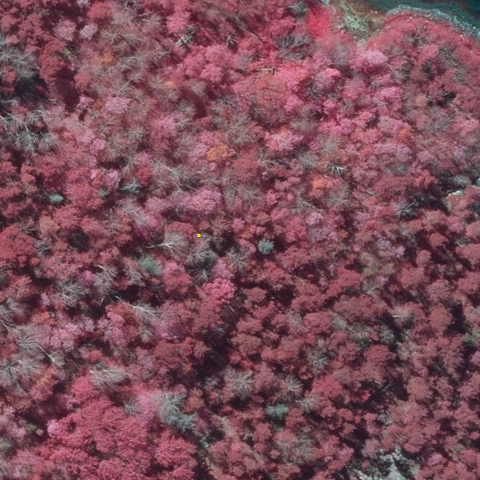Contact
Henrik Hedenås, Program Manager
Department of Forest Resource Management/Division of Landscape Analysis, SLU
henrik.hedenas@slu.se, 090-786 86 41

During the inventory in aerial images, tracts and plots that guaranteed do not contain any of the targeted habitats are identified. These sample plots do not need to be inventoried in the field, and the inventory in the field can thus focus on tracts that potentially contain the targeted habitats.
The inventories consist of two inventory steps
The first step is an inventory in aerial images and the second step is an inventory in the field.
The purpose of areal images inventory
The aim of areal images inventory is to identify potential habitats within the plots using a classification scheme (see the classes here, which are also described in more detail in the manual linked below). The classes and attribute derived from the areal images inventory are then combined to selection classes, which are used to randomly select the sample plots to be visited in the field. The aerial inventory is conducted jointly for the grassland and deciduous forest inventories, so that the each sample plot only needs to be evaluated once.
Aerial images in near-infrared
In high-resolution 3D aerial images captured in the near-infrared range, the topography of nature is followed and the differences in reflectance between different types of vegetation and their health status are greatest within the infrared spectrum. The image shows a deciduous forest plot from the NILS deciduous forest inventory with patches of pine forest in central Sweden during early summer. The different timing of leaf emergence gives a varied image, providing an opportunity to identify different broadleaved tree species.
Exclusion of tracts and plots
During the inventory in aerial images, whole tracts and single plots that do not contain any of the focal habitats are identified. These plots do not need to be visited in the field, and the field inventory can thus be focused on tracts and plots that potentially contain the focal habitats. The tracts that are not inventoried in the field are still part of the sample and contribute to the strength of the estimates.
The number of plots and tracts surveyed varies slightly between years in the five-year inventory phase. In 2022 inventory the sample included 133,288 plots in 680 tracts, which were surveyed through aerial images. Of these, 1,311 plots in 235 tracts were surveyed in the field.
Figure 1. The figure shows, firstly, the sample from the start, and then the status portal (API) used to allocate tasks and receive registered data during field surveying. Green dots represent completed areas, while red dots represent areas that have not yet been surveyed. In the top right corner, a selected area with sample plots is visible, and below it, one of the visited sample plots is shown.
In addition to aerial images, we utilize a series of orthophotos from Lantmäteriet which provide a historical perspective dating back to the 1950s and 60s. Although the dates vary across the country, the series available in each location provides valuable insight into how the land has been managed, including afforestation and cutting patterns. This information provides a good opportunity to assess the probability of whether a field layer under the tree cover, shrub cover, or more open areas has the potential to contain high nature or cultural values. Lantmäteriet also offers a range of maps, including historic ones like the Häradskartan. The example shows a tree-covered pasture that has been relatively continuously managed over time, with shorter breaks. Recently, the older trees have been cleared out and opened up, which also provides better views of the lake for those who built a house between 2014 and 2018.
Figure 2. Example of change over time. A tree-covered pasture in 1961 gradually grew into a deciduous forest over the years. Around 2018 (which was an exceptionally dry year), the land has been cleared and restored to a more open pasture.
Hierarchical classification
To ensure that all interesting habitat types are included in the field inventory, we apply a hierarchical classification system. Thus, there is always a class for each nature type, even when unsure about the management status or proportion of deciduous trees, but which may have a lower number of field visits. For variables such as cover of deciduous tree, an extra attribute is selected to indicate how confident the classification is. You can read more about the inventory in aerial images within deciduous forests and grasslands in Allard et al. 2021
Calibration and training
Personnel are calibrated every year before and continuously during the inventory in aerial images. After field data has been collected, a validation and further calibration takes place when the manual is adjusted, and definitions can be made clearer for both inventories
Henrik Hedenås, Program Manager
Department of Forest Resource Management/Division of Landscape Analysis, SLU
henrik.hedenas@slu.se, 090-786 86 41